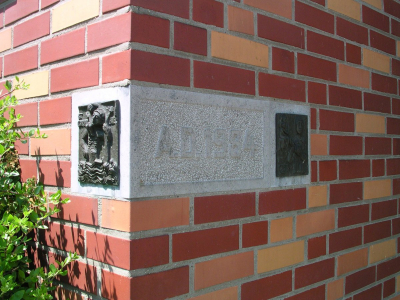The Shrine of the Three Kings (German Dreiknigsschrein or Der Dreiknigenschrein), Tomb of the Three Kings, or Tomb of the Three Magi is a reliquary traditionally believed to contain the bones of the Biblical Magi, also known as the Three Kings or the Three Wise Men. The shrine is a large gilded and decorated triple sarcophagus placed above and behind the high altar of Cologne Cathedral in western Germany. Built approximately from 1180 to 1225, it is considered the high point of Mosan art and the largest reliquary in the Western world.
The cornerstone (or foundation stone or setting stone) is the first stone set in the construction of a masonry foundation. All other stones will be set in reference to this stone, thus determining the position of the entire structure.
Over time a cornerstone became a ceremonial masonry stone, or replica, set in a prominent location on the outside of a building, with an inscription on the stone indicating the construction dates of the building and the names of architect, builder, and other significant individuals. The rite of laying a cornerstone is an important cultural component of eastern architecture and metaphorically in sacred architecture generally.
Some cornerstones include time capsules from, or engravings commemorating, the time a particular building was built.

1248Aug, 15
The foundation stone of Cologne Cathedral, built to house the relics of the Three Wise Men, is laid. (Construction is eventually completed in 1880.)
Choose Another Date
Events on 1248
- 20Jun
Royal charter
The University of Oxford receives its Royal charter. - 25Aug
Roman Catholic Archdiocese of Utrecht
The Dutch city of Ommen receives city rights and fortification rights from Otto III, the Archbishop of Utrecht. - 23Nov
Ferdinand III of Castile
Conquest of Seville by Christian troops under King Ferdinand III of Castile.

 English
English  español
español  français
français  português
português  русский
русский  العربية
العربية  简体中文
简体中文 